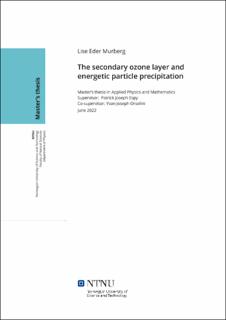| dc.contributor.advisor | Espy, Patrick Joseph | |
| dc.contributor.advisor | Orsolini, Yvan Joseph | |
| dc.contributor.author | Murberg, Lise Eder | |
| dc.date.accessioned | 2022-09-21T17:20:12Z | |
| dc.date.available | 2022-09-21T17:20:12Z | |
| dc.date.issued | 2022 | |
| dc.identifier | no.ntnu:inspera:115383357:21014899 | |
| dc.identifier.uri | https://hdl.handle.net/11250/3020501 | |
| dc.description.abstract | Det sekundære ozonlaget er det globale toppunktet av ozon i øvre mesosfære-nedre termosfære (UMLT) rundt 90-100 km. Ved denne høyden fotodissosieres ozon lett på dagtid, noe som gjør at blandingsforholdet av ozon er større om natten. Ved kjemisk likevekt er ozon om natten styrt av temperatur og kjemiske arter som atomært oksygen og atomært hydrogen, som fungerer som kilder og synker. Energisk partikkelnedbør (EPP) fra heliofysiske og geomagnetiske prosesser er kjent for å påvirke det primære- (stratosfæriske) og det tertiære- (mesosfæriske) ozonlaget, men effekten av EPP for UMLT ozon er ennå ikke studert. Denne studien bruker NASAs Microwave Limb Sounder (MLS) ozon volumsblandingsforhold (VMR) på natten, CO VMR på natten og temperatur sammenlignet med daglig Ap-indeks, som indikerer nivået av geomagnetisk aktivitet i atmosfæren. Karbonmonoksid (CO) har blitt brukt som en sporer av dynamiske endringer i UMLT. Modellen SD-WACCM-X har blitt brukt til å studere sirkulasjonseffekter fra EPP i UMLT. MLS V5.0 har blitt sammenlignet med MLS V4.2X ved trykknivå 0,002 hPa, og viser forbedringene i nattlig O3 VMR for MLS V5.0. De naturlige variasjonene på grunn av årstider, temperatur og dynamiske effekter er studert ved 0,001 hPa for MLS V5.0. Sesongmessige lengdegrads-gjennomsnitt for ozon VMR ved høy og lav Ap viser en ozon-økning for høye breddegrader i vintersesongene. I overgangssesongene (MAM og SON) for høye breddegrader er det en ozon-nedbrytning for sen høst og en ozon-forsterkning for tidlig vår. Resultated fra SD-WACCM-X viser at EPP påvirker sirkulasjonen og dermed påvirker ozon gjennom transport- og temperatureffekter. En eksempelstudie av 7-10. Nov 2004 og en overlagt-epokeanalyse (SEA) av DJF fører videre til konklusjonen at meridionalsirkulasjonen fører til temperatur- og sammensetningsendringer som påvirker det sekundære ozonlaget. | |
| dc.description.abstract | The secondary ozone layer is a global peak in ozone abundance in the upper mesosphere-lower thermosphere (UMLT) around 90-100 km. At this altitude ozone is easily photo-dissociated during daytime, making the ozone mixing ratio larger in nighttime. Nighttime ozone in chemical equilibrium is governed by temperature and species such as atomic oxygen and atomic hydrogen, which acts as chemical sources and sinks. Energetic particle precipitation (EPP) from heliophysical and geomagnetic processes is known to influence the primary (stratospheric) and tertiary (mesospheric) ozone layers, but the effect of EPP on UMLT ozone has not yet been studied. This study uses NASA's Microwave Limb Sounder (MLS) nighttime ozone volume mixing ratio (VMR), nighttime CO VMR and temperature compared to daily Ap indices, which indicates the level of geomagnetic activity in the atmosphere. Carbon monoxide (CO) has been used as a tracer of the dynamical changes in the UMLT. The SD-WACCM-X model has been used to study residual circulation effects from EPP in the UMLT. MLS V5.0 is compared to MLS V4.2X at 0.002 hPa, showing the improvements of nighttime O3 VMR in MLS V5.0. The natural variations due to seasons, temperature and dynamical effects is studied at 0.001 hPa for MLS V5.0. Seasonal zonal-means of ozone VMR at high and low Ap show an ozone enhancement at high latitudes for winter seasons. For transitional seasons (MAM and SON) at high latitudes there is an ozone depletion for late autumn and an ozone enhancement for early spring. SD-WACCM-X results show that EPP affects the residual circulation and thus affecting ozone through transport and temperature effects. A case study analysis of 7-10. Nov 2004 and a Superposed Epoch Analysis (SEA) of DJF further support the conclusion that the meridional circulation leads to temperature and composition changes which influence the secondary ozone layer. | |
| dc.language | eng | |
| dc.publisher | NTNU | |
| dc.title | The secondary ozone layer and energetic particle precipitation | |
| dc.type | Master thesis | |
